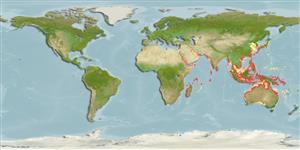>
Eupercaria/misc (Various families in series Eupercaria) >
Sillaginidae (Smelt-whitings)
Etymology: Sillago: From a locality in Australia.
Environment: milieu / climate zone / depth range / distribution range
Ecologia
marinhas; estuarina associadas(os) a recifes; anfídromo (Ref. 51243); intervalo de profundidade 0 - 60 m (Ref. 6205), usually 0 - 2 m (Ref. 90102). Tropical; 26°C - 29°C (Ref. 4959); 41°N - 36°S, 20°E - 166°E (Ref. 6205)
Indo-West Pacific: southern Red Sea (Ref. 94953) and Knysna, South Africa to Japan and south to Australia. Reported from New Caledonia (Ref. 9070). In Japan, this name has often been misapplied to Sillago japonica; often misidentified as Sillago lutea or Sillago vincenti.
Length at first maturity / Tamanho / Peso / Idade
Maturity: Lm 16.7, range 13 - 19.1 cm
Max length : 31.0 cm SL macho/indeterminado; (Ref. 44894); common length : 20.0 cm SL macho/indeterminado; (Ref. 9679); Idade máx. registada: 7 anos (Ref. 43081)
Espinhos dorsais (total) : 11 - 13; Raios dorsais moles (total) : 20 - 23; Espinhos anais: 2; Raios anais moles: 18 - 23. Swim bladder with two anterior and two posterior extensions. The anterior extensions extend forward and diverge to terminate on each side of the basioccipital above the auditory capsule. Two lateral extensions commence anteriorly, each sending a blind tubule anterolaterally and then extending along the abdominal wall below the investing peritoneum to just posterior of the duct-like process. Two posterior tapering extensions of the swim bladder project into the caudal region, one usually longer than the other. The species has a low lateral line with about 70 scales (Ref. 48635).
Common along beaches, sandbars, mangrove creeks and estuaries. Recorded from freshwater. Form schools. Adults bury themselves in the sand when disturbed (Ref. 6205, 44894). Feed mainly on polychaete worms, small prawns (Penaeus), shrimps and amphipods (Ref. 6226, 6227, 44894). Oviparous (Ref. 205). Larvae and juveniles are pelagic feeding on planktonic (Ref. 43081). Rarely captured by prawn trawling vessels. Marketed fresh and frozen (Ref. 9987).
McKay, R.J., 1992. FAO Species Catalogue. Vol. 14. Sillaginid fishes of the world (family Sillaginidae). An annotated and illustrated catalogue of the sillago, smelt or Indo-Pacific whiting species known to date. Rome: FAO. FAO Fish. Synop. 125(14):87p. (Ref. 6205)
Categoria na Lista Vermelha da IUCN (Ref. 130435: Version 2024-2)
Ameaça para o homem
Harmless
Utilização humana
Pescarias: espécies comerciais; Aquacultura: espécies comerciais
Ferramentas
Relatórios especiais
Descarregue XML
Fontes da internet
Estimates based on models
Preferred temperature (Ref.
123201): 24.8 - 29.2, mean 28.5 °C (based on 3250 cells).
Phylogenetic diversity index (Ref.
82804): PD
50 = 0.5000 [Uniqueness, from 0.5 = low to 2.0 = high].
Bayesian length-weight: a=0.00575 (0.00480 - 0.00689), b=3.06 (3.01 - 3.11), in cm total length, based on LWR estimates for this species (Ref.
93245).
Nível Trófico (Ref.
69278): 3.3 ±0.1 se; based on diet studies.
Resiliência (Ref.
120179): Elevada, tempo mínimo de duplicação da população menor que 15 meses (K=0.75-1.22; tm=1; tmax=4; Fec=16,682).
Prior r = 0.79, 95% CL = 0.52 - 1.19, Based on 1 data-limited stock assessment.
Fishing Vulnerability (Ref.
59153): Low vulnerability (24 of 100).
Climate Vulnerability (Ref.
125649): Moderate vulnerability (43 of 100).
Nutrients (Ref.
124155): Calcium = 208 [37, 506] mg/100g; Iron = 0.719 [0.238, 1.909] mg/100g; Protein = 21 [18, 23] %; Omega3 = 0.0971 [, ] g/100g; Selenium = 31 [9, 139] μg/100g; VitaminA = 113 [19, 650] μg/100g; Zinc = 1.42 [0.69, 3.58] mg/100g (wet weight); based on
nutrient studies.
